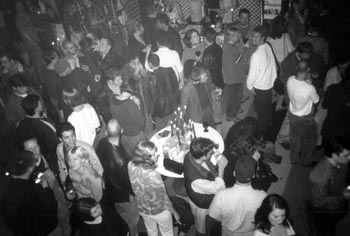Hipster Porn
Non-Bar Environment: For parties like Salon 4.25, the Werepad serves as the headquarters for a film company, studio, sound stage and movie theater.
Going to a show at the Werepad, whether it be a movie or a cabaret, means more than just buying a ticket, taking a seat, shutting up and staring
By Michelle Goldberg
The Werepad is the kind of space that every artist with Andy Warhol dreams longs to land in San Francisco. For the four filmmakers who live in the warehouse on the far side of Potrero Hill, the space serves as headquarters for their film company, Massacre at Central Hi, as well as a studio, sound stage and movie theater. And every other month, when Jacques Boyreau, Cornelia Jensen, Scott Moffett and Vicki Vaden throw a benefit to keep Massacre at Central Hi alive, it also becomes one of the most electrifying parties in San Francisco. At the last one, Salon 4.25, girls in slinky evening dresses that revealed tattooed shoulders, along with boys wearing vintage suits and fedoras (or old jeans and T-shirts), gathered in the dark, musty, sexy space for an evening of art, exploitation film, noise-bands, cabaret and cocktails served by busty women in tattered lingerie.
"We wanted to make an atmosphere where people could come in and have an evening," says Vaden, who organized the Salon. "They wouldn't just watch a film. There's art, drinks, conversation. It's a non-bar environment. With all the talent that's going on in the city, people are trying to focus more on stage acts."
Those stage acts included a country & western duet by Richard Rockstar and Jonona Jupiter, a fire-eating vaudeville act called The Flaming Wanton show and a drag queen named Jordan L'Moore, as well as numerous dissonant rock bands, films and occasionally pornographic video.
Like Anon Salon, the Werepad has had a hand in breaking down the barriers between socializing and spectatorship. "It's not your usual movie experience," says Boyreau. "One time we were showing a biker film and a crazy guy in the audience started to go nuts, and people thought we had staged it."
The Werepad is one of San Francisco's ultimate DIY success stories--they've already produced three 60-minute features and a series of collages of excavated footage called Hollywood Shrapnel, as well as CDs and other Werepad paraphernalia. Most weekends they have benefit screenings where they show both their own movies and selections from their archive of more than 400 rarely seen cult films, films Boyreau calls "whitesploitation."
Boyreau is the tall, curly-haired, Ayn Rand-reading auteur behind Massacre at Central Hi. A Brown graduate, he's both hyperarticulate and refreshingly angry, especially about his bête noire--what he calls "slob culture," that nihilistic urban stew composed of "hippie leftovers, punk rock leftovers, grunge leftovers and postmodernist leftovers."
"Slob culture is kind of a virus, an illness, that promotes slovenliness in the name of attitude," he says. "You can't even say it's rebellion. It's just attitude, ignorance in the name of coolness. It's a virulent fog that people get sucked into when they cease making the effort to improve themselves and to be disciplined about how they see themselves. The slob is like the Caucasian equivalent of the pimp. These two concepts are thoughtlessly elevated, and people get off on them thoughtlessly.
"Whitesploitation is the other side of blaxploitation," he continues. "There's certain kinds of fantasies of freedom that are associated with blaxploitation. Different role models are associated with whitesploitation. Blaxploitation is about fantasies of gaining control; whitesploitation is about fantasies of losing control. There are certain archetypes--the mad hippie, the visionary biker, the junkie rock & roll star, the feminist bitch-goddess slut."
These archetypes are all over Massacre at Central Hi's films, which range from the über-artsy Hippy Porn, (a merger between Godard and Andy Warhol, Boyreau says) to the sex-drugs-and-loud-guitars shocker In. The difference between the two tells much about the evolution of the Werepad aesthetic.
"Hippy Porn definitely had more of the art-film attitude," says Boyreau. "I went through years of showing that film and dealing with back-stabbing partners and incredibly disgruntled and bored audiences. I was really being force-fed with the reality of how the film interacts with the audience, and I got major radiation burns from the whole so-called indie scene. With In, we were like, people might be revolted, but nobody's going to bored. Even though we love art films, we're trying to make our films have that kind of momentum that people associate with entertainment. We have a real ferocious need to entertain."
[ San Francisco | MetroActive Central | Archives ]
Copyright © Metro Publishing Inc. Maintained by Boulevards New Media.
![]()

Matthew Ipcar
Call the Werepad for info. 415/824-7334.
From the May 18-31, 1998 issue of the Metropolitan.
![[MetroActive Music]](http://metroactive.com/music/gifs/music468.gif)